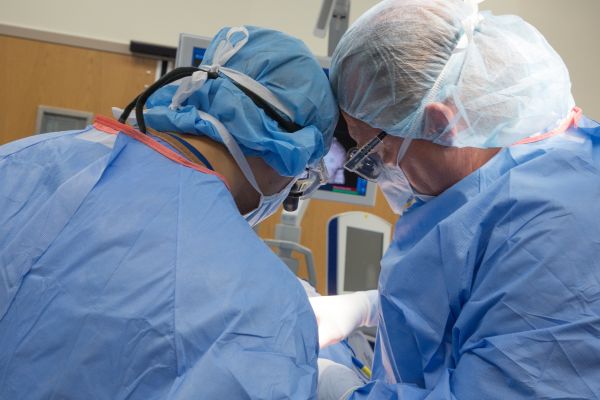Often caused by a benign pituitary tumor, this condition requires highly specialized care
Cushing’s disease is an uncommon condition that occurs when the body makes too much of the hormone cortisol, most often the result of a tumor of the pituitary gland. Although pituitary tumors are usually benign (not cancerous), the disease is still serious and requires the same high-level experience and comprehensive care necessary for cancerous tumors.
“It is a complex disease that is tough to treat, but the important thing to know is that it is amenable to treatment,” says Robert Fenstermaker, MD, Chair of the Department of Neurosurgery at Roswell Park Comprehensive Cancer Center. “If not controlled, it can shorten life and drastically affect the quality of life. So, it is important to make a diagnosis and treat it properly.”
What causes Cushing’s disease?
The small pituitary gland located at the base of the brain controls release of a host of hormones, including one called adrenocorticotropic hormone (ACTH). In turn, ACTH signals the adrenal glands on the kidneys to produce and release cortisol, a stress hormone that also helps control the metabolism of carbohydrates, fats and proteins, regulate blood pressure and reduce inflammation.
Cushing’s disease results when a tumor called an adenoma, usually non-cancerous, grows on the pituitary gland and causes the release of too much ACTH, and then too much cortisol. “These tumors can be extremely tiny, just 2 millimeters in size, and difficult to find sometimes,” Dr. Fenstermaker says. “This is one more reason to seek treatment from experts in tumor treatment.”
Symptoms to tell your doctor
Having too much cortisol affects every organ in the body. Common symptoms of too much cortisol include:
- Weight gain, especially above the waist, and weight loss in the arms and legs.
- Fat between the shoulders, known as “buffalo hump.”
- Facial changes creating a round, red, “moon” face.
- Slow growth rate in children.
- Skin changes, including acne and other skin infections that may appear as purple stretch marks on the abdomen, thighs, upper arms and breasts, and easy bruising on the arms and hands.
- Weakness and pain in muscles and bones.
- Depression, anxiety and other mental or behavioral changes.
- High blood pressure.
- Diabetes
- Increased thirst and urination.
Women may also experience excess hair growth on the face, neck, chest, abdomen, and thighs; and an irregular or stopped menstrual cycle. Men may experience low or no sex drive and erectile dysfunction.
If your doctor suspects Cushing’s disease, you’ll likely undergo a 24-hour urine collection to measure cortisol levels. Sometimes, a blood test is also indicated. Other tests may follow if high cortisol levels are confirmed, including a brain scan to detect whether a pituitary tumor is present.
Advanced neurosurgical care leads the treatment
The primary treatment of Cushing’s Disease is removal of the tumor, either by direct surgery, radiation-based surgery, or to lesser extent, medical management. The surgery is complex and requires a multidisciplinary team of neurosurgeons working with specialized head and neck surgeons to navigate around critical structures within millimeters. In order to reach the pituitary gland, the operation is done through the nose. First, a head and neck surgeon creates an opening through the sinus and a neurosurgeon extracts the tumor.
“While the operation is safer than the average neurosurgical procedure,” says Dr. Fenstermaker, “there still is potential for significant problems such as spinal fluid leakage. These potential complications need to be expertly managed.” Treatment of the pituitary gland with radiation may also be needed if the tumor cannot be completely removed. If the tumor cannot be treated with either surgery or radiation, medication may be able to control the overproduction of cortisol.
Treating pituitary tumors
You need specialized care when cancer affects your endocrine system. Roswell Park provides comprehensive diagnostic and treatment services to patients with benign or malignant brain tumors and conditions affecting the endocrine system, including pituitary tumors.
Recovery from pituitary tumor surgery
Patients typically stay in the hospital two to three days to manage changes in metabolism by removal of the tumor. “They are usually back to driving in two weeks and all other activities, including work, in about a month,” says Dr. Fenstermaker. Although it’s rare for a pituitary tumor to recur, the recurrence rate is for tumors associated with Cushing’s disease is a little higher, explains Dr. Fenstermaker, and more difficult to manage when that happens.
“That’s why our multidisciplinary team approach here at Roswell Park is extremely important,” he says. “It takes careful follow up and coordination between the neurosurgeon and endocrinologist. Even though a Cushing’s disease tumor is not usually cancerous, the surgical techniques and skills are the same whether it’s benign or malignant. If you are diagnosed with Cushing’s disease, you should go to a team with the expertise and experience with the disease and surgery techniques,” advises Dr. Fenstermaker.




